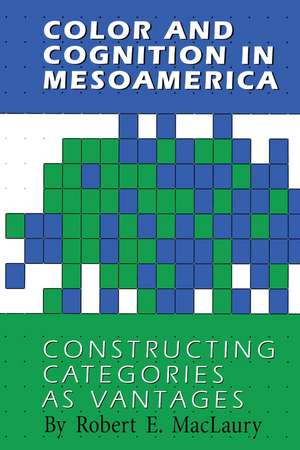Color and Cognition in Mesoamerica: Constructing Categories as Vantages
Autor Robert E. MacLauryen Limba Engleză Paperback – feb 1997
This book presents the results of the Mesoamerican Color Survey, which Robert E. MacLaury conducted in 1978-1981. Drawn from interviews with 900 speakers of some 116 Mesoamerican languages, the book provides a sweeping overview of the organization and semantics of color categorization in modern Mesoamerica.
Extensive analysis and MacLaury's use of vantage theory reveal complex and often surprising interrelationships among the ways languages categorize colors. His findings offer valuable cross-cultural data for all students of Mesoamerica. They will also be of interest to all linguists and cognitive scientists working on theories of categorization more generally.
Preț: 487.62 lei
Nou
Puncte Express: 731
Preț estimativ în valută:
93.31€ • 99.78$ • 77.80£
93.31€ • 99.78$ • 77.80£
Carte tipărită la comandă
Livrare economică 18 aprilie-02 mai
Preluare comenzi: 021 569.72.76
Specificații
ISBN-13: 9780292729551
ISBN-10: 0292729553
Pagini: 644
Dimensiuni: 152 x 229 x 15 mm
Greutate: 0.93 kg
Editura: University of Texas Press
Colecția University of Texas Press
ISBN-10: 0292729553
Pagini: 644
Dimensiuni: 152 x 229 x 15 mm
Greutate: 0.93 kg
Editura: University of Texas Press
Colecția University of Texas Press
Notă biografică
The late Robert E. MacLaury held a Ph.D. in cognitive anthropology from the University of California at Berkeley.
Cuprins
- Foreword by John R. Taylor
- Preface
- Acknowledgments
- Permissions
- Conventions
- Part One. Preliminaries
- 1. Conceptual and Material Equipment
- 1.1. Influential Concepts
- 1.2. Stimulus Materials
- 1.2.1. A Short History of Standards
- 1.3. Summary
- 2. Issues in Color Ethnography
- 2.1. Language versus Vision: An Evolutionary Debate
- 2.2. Crosscultural Perception
- 2.3. Relativism
- 2.4. Universalism à la Berlin and Kay
- 2.4.1. The 1975 Hue Sequence
- 2.4.2. Fuzzy Sets and Neural Response Categories
- 2.4.3. Semiotic Models
- 2.4.4. Surveys and Reformulation
- 2.5. A Dynamic Model
- 2.6. World Overview
- 2.7. Summary
- 3. Descriptive Method
- 3.1. Equipment
- 3.2. Elicitation
- 3.3. Display of Individual Data
- 3.3.1. Naming Ranges and Qualifier Distributions
- 3.3.2. Foci
- 3.3.3. Mappings
- 3.4. Analysis of Individual Data
- 3.4.1. Naming Ranges and Mappings
- 3.4.2. Correspondence among Mappings
- 3.4.3. Qualifiers and Mappings
- 3.4.4. Complementation of Qualifiers
- 3.5. Summary
- 4. Axioms
- 4.1. Perceptual Axioms
- 4.1.1. Evidence
- 4.1.1.1. Discrimination Distance
- 4.1.1.2. The Disadvantage of Short-Wavelength Cones
- 4.1.1.3. Other Evidence
- 4.1.1. Evidence
- 4.2. Cognitive Axioms
- 4.3. Motivation
- 4.4. Engagement of Axioms
- 4.5. Using the Axioms
- 4.5.1. Tzeltal Hue Categories
- 4.5.2. A Model of Variation in Tzeltal Color Categorization
- 4.5.3. Issues of Theory
- 4.6. Summary
- 4.1. Perceptual Axioms
- 1. Conceptual and Material Equipment
- Part Two. Viewpoint and Category Change: A Continuous Typology of Relations
- 5. Coextensive Semantic Ranges
- 5.1. Characteristics of Coextension
- 5.1.1. Coextension in the Warm Category
- 5.1.2. Coextension in the Cool Category
- 5.1.3. Coextension in Two Environments
- 5.2. Coextension in Relation to Other Semantic Types
- 5.3. Semantic Evolution in Two Environments
- 5.4. Summary
- 5.1. Characteristics of Coextension
- 6. Vantages
- 6.1. The Dominant-Recessive Pattern of Coextension
- 6.1.1. Variation on a Continuum
- 6.1.2. The Null Hypothesis
- 6.1.3. Alternative Explanations
- 6.2. Categorization as Spatiotemporal Analogy
- 6.2.1. Vantages and Coordinates
- 6.2.2. Relativity of Coordinates
- 6.2.3. Formalisms
- 6.2.3.1. Different Sizes of Dominant and Recessive Ranges
- 6.2.3.2. Increase of the Size Differential
- 6.2.3.3. Near Synonymy, Coextension, and Inclusion
- 6.2.3.4. Complementation
- 6.2.4. Pragmatics
- 6.2.5. Summation
- 6.3. Descriptions of Coextension
- 6.3.1. Early Coextension
- 6.3.2. Late Coextension
- 6.3.3. Dominant and Recessive Qualifiers
- 6.3.4. Lexical Borrowing
- 6.3.5. Triple Coextension
- 6.3.6. Balanced Coextension
- 6.3.7. Systems Not in Table 6.1
- 6.3.8. Foci of the Warm Category
- 6.4. Implications of Vantage Theory
- 6.4.1. Analogy on the Level of Coordinates
- 6.4.2. Phylogeny
- 6.4.3. Human versus Animal Categorization
- 6.4.4. Innateness
- 6.4.5. Embodiment
- 6.4.6. A Vantage Is Always Part of a Category
- 6.4.7. Coordinates versus Features
- 6.4.8. Primary Motivation versus Function
- 6.4.9. Alternative Accounts of Color Categorization
- 6.4.10. Etic and Emic
- 6.4.11. Point of View and Fuzziness
- 6.4.12. Boundaries
- 6.4.13. Contextualization and Connotation
- 6.4.14. Category Change
- 6.4.15. Judgments of Similarity and Difference within Categories
- 6.4.16. Judgments of Asymmetry within Categories
- 6.4.17. Reference Point Reasoning
- 6.4.18. Categorical Perception versus Weber's Law
- 6.4.19. Relativity and Universality
- 6.4.20. Is the Space-Time Analogy Alive or Dead?
- 6.4.21. Speed and Productivity
- 6.4.22. Is It Possible to Categorize without Constructing a Vantage?
- 6.5. Summary
- 6.1. The Dominant-Recessive Pattern of Coextension
- 7. Category Division
- 7.1. Pulling Apart the Warm Category
- 7.1.1. Superordination in Reference to Yellow
- 7.1.2. Superordination in Reference to Red
- 7.1.3. Inclusion to Complementation
- 7.1.4. Polarized Inclusion
- 7.1.5. Notions of Categorization
- 7.2. Mirror Images of the Dark-Cool Category
- 7.2.1. Categories of Elemental Color
- 7.2.2. Categories of Brightness
- 7.3. The Elusive Light-Warm Category
- 7.4. Summary
- 7.1. Pulling Apart the Warm Category
- 5. Coextensive Semantic Ranges
- Part Three. Further Dynamics, Reflectivity, and Complex Categorization
- 8. Skewing and Darkening
- 8.1. Skewing
- 8.1.1. Degree of Skewing
- 8.1.2. Direction of Skewing
- 8.2. Quantification
- 8.2.1. Outline of Major Numbers
- 8.2.2. Descriptions and Analyses
- 8.2.2.1. Statistics on the Direction of Skewing
- 8.2.2.2. Statistics on the Degree of Skewing
- 8.2,2.3. Statistics on Darkening
- 8.2.2.4. Statistics on the Dominant-Recessive Pattern
- 8.2.2.5. Statistics on Transference
- 8.2.2.6. Miscellaneous Statistics
- 8.2.3. Synopsis
- 8.3. Darkening
- 8.4. Qualifiers and Skewing
- 8.5. Aggregates of Foci in Specific Languages
- 8.6. Transference versus Areal Diffusion
- 8.7 Summary
- 8.1. Skewing
- 9. Submerged Versus Reflective Categorization
- 9.1. Single Foci
- 9.2. Dual Foci
- 9.3. Triple Foci
- 9.4. Overviews of Viewpoints
- 9.4.1. Kinds of Thinking
- 9.4.2. In Common Terms
- 9.4.3. In Formal Terms
- 9.5. Distinguishing Closely versus Customarily Taking an Overview
- 9.6. Summary
- 10. Crossover
- 10.1. Crossover and Coextension
- 10.2. Crossover and Inclusion
- 10.3. An Areal Study
- 10.4. Qualifier Coextension
- 10.5. Brightness Coextension
- 10.6. Summary
- 11. Transference Versus Diffusion: Mesoamerica Compared With the World
- 11.1. The Cool Category in Global Perspective
- 11.2. Results of Skewing
- 11.3. Conditions That Affect Skewing
- 11.3.1. Crossover
- 11.3.2. Brightness Categories Focused in Blue
- 11.3.3. Brightness Categories Focused in Yellow
- 11.3.4. Yellow-with-Green Hue Categories
- 11.3.5. Coextensive Naming
- 11.3.6. Incipient Transference
- 11.4. Transference in State Societies
- 11.5. Summary
- 8. Skewing and Darkening
- Part Four. Conclusion
- 12. Color and Categorization
- 12.1. Three Levels of Analysis
- 12.1.1. Raw Observations
- 12.1.2. A Model of Color Categorization
- 12.1.2.1. Axioms and Dynamics
- 12.1.2.2. Points of View and Frames of Reference
- 12.1.2.3. Simplex and Complex Categorization
- 12.1.2.4. Flip-Flop
- 12.1.3. A Theory of Categorization
- 12.1.1. Raw Observations
- 12.1. Three Levels of Analysis
- 12. Color and Categorization
- Appendix I. Inventory of Data, Collaborators, Languages, and Locations
- Appendix II. Linguistic Relations
- Appendix III. Technical Information
- Appendix IV. A Cognitive Ceiling of Eleven Basic Color Terms
- Appendix V. North and South of Mesoamerica
- Appendix VI. Data Organization Methods
- Appendix VII. Inventory of Observations
- Appendix VIII. Formulae
- Notes
- Glossary
- Bibliography
- Name Index
- Language Index
- Subject Index
Descriere
Linguistic data on color names from speakers of 116 Mesoamerican languages.
















